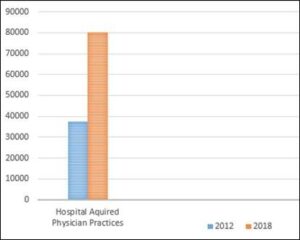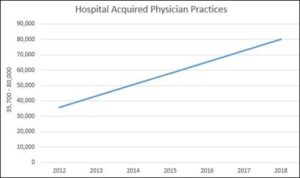How the Trend of Hospitals Acquiring Physician Practices Will Change Healthcare

Change has long been synonymous with the healthcare industry. Despite a host of breakthroughs in innovation and research, there are new trends that instantly grab our attention. One dramatic example was recently reported by the Physicians Advocacy Institute and Avalere Health. They found that hospital acquisitions of physicians groups rose by an incredible 128% from 2012 to 2018.

In June of 2012, the same organizations (Physicians Advocacy Institute and Avalere Health) reported there were only 35,700 hospital-owned physician practices. By the start of 2018, that number skyrocketed to 80,000 hospital-owned physician practices.

As Tara Bannow writing for Modern Healthcare says, it is not just a one-way race with large hospitals/health systems in the lead. Private equity firms and payers are also powerful competitors in the mergers and acquisitions arena. In 2018, buyers focused their energies on acquiring specialty practices including orthopedics, gastroenterology, dentistry, and dermatology; primary care practices were also in demand.

How mergers and acquisitions benefit both smaller providers and larger healthcare organizations
The healthcare organizations mentioned above share the following objectives: to increase consumer engagement, improve quality of care, and minimize costs. In many cases, mergers and acquisitions bring together large and small care providers to boost their brand awareness and add to their existing capabilities.
In large hospitals and health systems, each department receives a different percentage of the overall organizational budget. Inconsistent standards of care can also occur within large healthcare networks. Both factors can foster an unhealthy spirit of competition between individual sections of a healthcare organization. Smaller sized physicians groups encourage a more cooperative approach to solve issues, promoting a culture of togetherness throughout the facility.
For smaller physician practices, entering into a partnership with a larger organization can be very beneficial. Larger providers offer added resources making it possible for smaller physician practices to implement technologies such as electronic medical records at a reduced cost. Another benefit is increased referrals (for specialist physician groups) from a wider array of healthcare providers.
How are mergers and acquisitions changing the industry?
With a dramatic upsurge of healthcare organizations acquiring specialist practices, you would expect waves of change to spread throughout the industry.
Today there is a constant back-and-forth debate between economists and healthcare leaders as to whether mergers and acquisitions will be positive or negative for the long-term future of the industry.
Paul B. Ginsburg, Director, USC Brookings, (testified March 16, 2016, before the California Senate Committee on promoting competition in mergers and acquisition market) argues the modern healthcare environment increases competitiveness; so smaller practices lack the resources to compete with larger organizations.
This is a challenging time for small providers. They are experiencing increasing pressure on payment rates. There are newer contracting models such as Accountable Care Organizations (ACOs) that require more scale. Additionally, they face a challenging transition to implement electronic medical records, a transition that is expensive and needs expertise.
Ginsburg adds that most of the time, the acquisitions allow small physician practices to continue to provide access to specialist medical services for their communities; without which, the smaller provider is likely to close their doors.
According to a 2017 report from the AHA (The American Hospital Association), acquisitions offer greater accessibility to financial and other resources for smaller providers; the result is lower healthcare costs. According to a 2016 NEJM report, the merging of two organizations allows them to share protocols, increasing the quality of care throughout an organization. However, a more current JAMA report showed that when two organizations join forces, they increase the risk of unfavorable patient safety instances. (https://patientengagementhit.com/news/how-do-healthcare-mergers-and-acquisitions-impact-patients cited by Sara Health in her article “How do Healthcare Mergers and Acquisitions Impact Patients”)
Looking at the current trend through a more critical eye, Ginsburg adds, mergers and acquisitions increase the likelihood of healthcare monopolies limiting patient choice. Assistant professor of medicine, Gregory Curfman, argues on similar lines to Ginsburg that mergers will result in decreased stakes in the healthcare market, placing providers in an awkward position of having to request insurance organizations to pay a larger piece of medical care and procedural costs. In the end, higher prices will equate to increased premiums for patients leading to higher healthcare costs. (https://patientengagementhit.com/news/how-do-healthcare-mergers-and-acquisitions-impact-patients cited by Sara Health in her article “How do Healthcare Mergers and Acquisitions Impact Patients”).

How rising mergers and acquisitions is affecting the healthcare industry
The continued upward trend of mergers and acquisitions does not appear to be slowing down. There is no definitive answer to if mergers and acquisitions will have positive or negative repercussions for the industry. Will mergers and acquisitions create monopolies, limiting competition, and increasing costs or enable a brighter future for smaller providers; time will tell.
